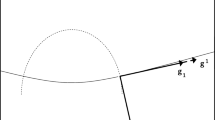Abstract
The methods of the mechanics of continuous media [1] are used to consider the problem of electrization of dielectric liquids flowing in tubes [2–6]. According to modern ideas [2–6], there is always dissolved in such liquids a slight admixture of an electrolyte, whose molecules in such a dilute solution dissociate to a certain extent into positively and negatively charged ions. On the walls, oxidizing and reducing reactions take place, as a result of which the negative and positive ions, respectively, give up to the wall surplus electrons or take missing electrons from it. Thus, a positive (respectively, negative) total electric charge is induced in the liquid by the flow. We consider in this paper the electrization of a dielectric liquid in laminar flow in a circular cylindrical tube. We find the distribution of the electric charge in the liquid, the maximal electric current, and the dependence of the length over which the distribution of the electric charge in the tube is established on the tube radius, the Debye radius of the liquid, and the Péclet diffusion number.
Similar content being viewed by others
Literature cited
L. I. Sedov, Mechanics of Continuous Media, Vol. 1 [in Russian], Nauka, Moscow (1973).
I. Koszman and J. Gavis, “Development of charge in low-conductivity liquids flowing past surfaces. Engineering predictions from the theory developed for tube flow,” Chem. Eng. Sci.,17, No. 12 (1962).
I. Koszman and J. Gavis, “Development of charge in low-conductivity liquids flowing past surfaces. Experimental verification and application of the theory developed for tube flow,” Chem. Eng. Sci.,17, No. 12 (1962).
V. V. Gogosov, E. I. Nikiforovich, and V. V. Tolmachev, “Electrization of a weakly conducting liquid flowing in a metallic tube,” in: Proc. Ninth Riga Symposium on Magnetohydrodynamics, Vol. 1, Riga, 1978 [in Russian], Izd. In. Fiziki, Akad. Nauk Latv. SSR, Salaspils (1978).
V. V. Zakharchenko, N. I. Kryachko, E. F. Mazhara, V. V. Sevrikov, and N. D. Gavrilenko, Electrization of Liquids and its Prevention [in Russian], Khimiya, Moscow (1975).
Electrostatics in Petroleum Industry, Elsevier, Amsterdam (1958).
V. A. Kireev, Course of Physical Chemistry [in Russian], Khimiya, Moscow (1975).
V. Ya. Arsenin, Mathematical Physics [in Russian], Nauka, Moscow (1966).
A. Erdélyi et al. (Eds), Higher Transcendental Functions, California Institute of Technology, H. Bateman MS Project, Vol. 1, McGraw-Hill, New York (1953).
E. Jahnke, F. Ende, and F. Lösch, Tables of Higher Functions, McGraw-Hill, New York (1960).
Author information
Authors and Affiliations
Additional information
Translated from Izvestiya Akademii Nauk SSSR, Mekhanika Zhidkosti i Gaza, No. 6, pp. 41–47, November–December, 1979.
We thank V. V. Gogosov for helpful comments made in a discussion of thwe work.
Rights and permissions
About this article
Cite this article
Pribylov, V.N., Chernyi, L.T. Electrization of dielectric liquids flowing in tubes. Fluid Dyn 14, 844–849 (1979). https://doi.org/10.1007/BF01051985
Received:
Issue Date:
DOI: https://doi.org/10.1007/BF01051985




